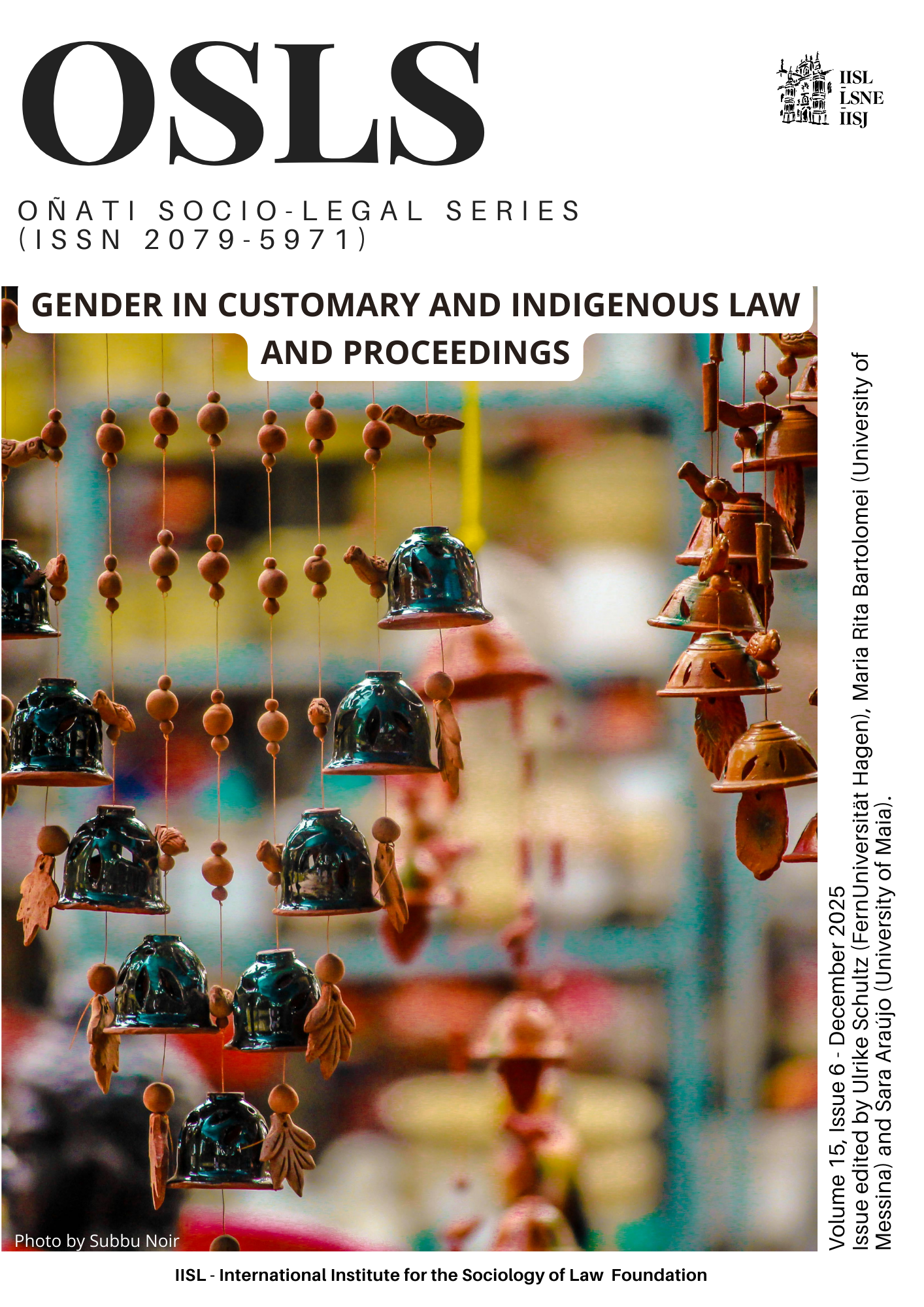From Relegation to Elevation
The Place of Customary Marriages under Kenya’s Matrimonial Law
DOI:
https://doi.org/10.35295/osls.iisl/1966Palavras-chave:
Gender, Customary law, Marriage, Family Law, African FeminismResumo
Kenya’s Marriage Act of 2014 was passed with the effect of harmonizing all matrimonial laws in operation in the country into one statute. The Marriage Act provides that all marriages in Kenya have equal legal status, and requires that all marriages, including those concluded under customary law, must be registered. This article analyses how customary marriages have been treated under Kenya’s law in three distinct time periods- the colonial, post-independence and contemporary Kenya. It argues that while customary marriages were treated as inferior during the colonial and post-independence periods, in contemporary Kenya, the Marriage Act has had the effect of elevating customary law marriages so that they are equal to marriages under other systems. Further, the article assesses the status of women married under customary law and demonstrates that the Marriage Act has resulted in the greater protection of the rights of married women in Kenya.
Downloads
Metrics
Estatísticas globais ℹ️
|
637
Visualizações
|
3160
Downloads
|
|
3797
Total
|
|
Referências
Abdullahi, A., 2002. Cultural transformation and human rights in African societies. In: A. Abdullahi, ed., Cultural Transformation and Human Rights in Africa. London: Zed Books, 13–37.
Bwire, B., 2019. Integration of African Customary Legal Concepts into Modern Law: Restorative Justice: A Kenyan Example. Societies [online], 9(1), 17–25. Available at: https://doi.org/10.3390/soc9010017 DOI: https://doi.org/10.3390/soc9010017
Commission on the Law of Marriage and Divorce, 1968. Report of the Commission on the Law of Marriage and Divorce.
Cotran, E., 1968. Kenya: The Law of Marriage and Divorce: Restatement of African Law. London: Sweet & Maxwell.
De Souza, M., 2013. When Non-Registration becomes Non-Recognition: Examining the Law and Practice of Customary Marriage Registration in South Africa. Acta Juridica, 239–272.
Galanter, M., 1981. Justice in Many Rooms: Courts, Private Ordering, and Indigenous Law. Journal of Legal Pluralism [online], 19, l–47. Available at: https://doi.org/10.1080/07329113.1981.10756257 DOI: https://doi.org/10.1080/07329113.1981.10756257
Ghai, Y.P., and McAuslan, P., 1970. Public Law and Political Change in Kenya. London: Oxford University Press.
Gifford, P., 2009. Christianity, Politics and Public Life in Kenya [online]. New York: Columbia University Press. Available at: https://doi.org/10.1057/9780230100510_8 DOI: https://doi.org/10.1057/9780230100510_8
Griffiths, M.O.A., 1997. In the Shadow of Marriage: Gender and Justice in an African Community. University of Chicago Press.
Harvey, W.B., 1975. An Introduction to the Legal System in East Africa. Nairobi: East African Literature Bureau.
Johnston, M., 1971. Review of the Report of the Commission on Marriage and Divorce. University of Pennsylvania Law Review [online], 119(6), 1075–79. Available at: https://doi.org/10.2307/3311208 DOI: https://doi.org/10.2307/3311208
Kameri-Mbote, P., 2013. Fallacies of Equality and Inequality: Multiple Exclusions in Law and Legal Discourses [online]. University of Nairobi. Available at: http://erepository.uonbi.ac.ke/handle/11295/10057
Kanogo, T., 1987. Squatters and the Roots of the Mau Mau 1905-63 [online]. London: James Currey. Available at: https://doi.org/10.1515/9781782049791 DOI: https://doi.org/10.1515/9781782049791
Kiage, P., 2016. Family Law in Kenya: Marriage, Divorce and Children. Nairobi: LawAfrica.
Lewin, J., 1939. Some Legal Consequences of marriage by native Christians in British Africa. Modern Law Review [online], 31(1), 48–52. Available at: https://doi.org/10.1111/j.1468-2230.1939.tb00745.x DOI: https://doi.org/10.1111/j.1468-2230.1939.tb00745.x
Mama, A., 2019. African Feminist Thought. Oxford Research Encyclopedia of African History [online]. Available at: https://doi.org/10.1093/acrefore/9780190277734.013.504 DOI: https://doi.org/10.1093/acrefore/9780190277734.013.504
Mikell, G., 1995. African feminism: Towards a new politics of representation [online]. Philadelphia: University of Pennsylvania Press. Available at: https://doi.org/10.2307/3178274 DOI: https://doi.org/10.2307/3178274
Morris, H.F., 1972. Indirect Rule and the Law of Marriage. In: H.F. Morris and J. S. Read, eds., Indirect Rule and the Search for Justice: Essays in East African Legal History. Oxford: Clarendon Press, 213–250.
Nyamu-Musembi, C., 2002. Are local norms and practices fences or pathways? The example of women's property rights. In: A An-Naim, ed., Cultural transformation and human rights in Africa, London: Zed Books.
Ojwang, D., Meroka, A., and Situma, F., 2016. Is Technology Used to Subordinate Socially Conservative Constitutions in Africa? The Case of Kenya’s Proposed Legislation on Assisted Reproductive Technology. Africa Nazarene University Law Journal, 4(1), 1–26.
Okoth-Ogendo, H.W.O., 1991. Tenants of the Crown. Nairobi: African Center for Technology Studies (ACTS).
South Africa Law Reform Commission, 2023. Project 100E: Review of Aspects of Matrimonial Property Law. South Africa Law Reform Commission.
Spenser, L.P., 1975. Christian Missions and African Interests in Kenya, 1905–1924 [online]. PhD Thesis. University of Syracuse. Available at: http://erepository.uonbi.ac.ke:8080/xmlui/handle/123456789/28901
Tamale, S., 2020. Decolonization and Afro-Feminism. Kampala: Daraja Press.
The Rejection of the Marriage Bill in Kenya, 1979. Journal of African Law [online], 23(2), 109–14. Available at: https://doi.org/10.1017/S0021855300010779 DOI: https://doi.org/10.1017/S0021855300010779
Downloads
Publicado
Como Citar
Edição
Seção
Licença
Copyright (c) 2023 Agnes Meroka-Mutua

Este trabalho está licenciado sob uma licença Creative Commons Attribution-NonCommercial-NoDerivatives 4.0 International License.
OSLS strictly respects intellectual property rights and it is our policy that the author retains copyright, and articles are made available under a Creative Commons licence. The Creative Commons Non-Commercial Attribution No-Derivatives licence is our default licence and it regulates how others can use your work. Further details available at https://creativecommons.org/licenses/by-nc-nd/4.0 If this is not acceptable to you, please contact us.
The non-exclusive permission you grant to us includes the rights to disseminate the bibliographic details of the article, including the abstract supplied by you, and to authorise others, including bibliographic databases, indexing and contents alerting services, to copy and communicate these details.
For information on how to share and store your own article at each stage of production from submission to final publication, please read our Self-Archiving and Sharing policy.
The Copyright Notice showing the author and co-authors, and the Creative Commons license will be displayed on the article, and you must agree to this as part of the submission process. Please ensure that all co-authors are properly attributed and that they understand and accept these terms.






















